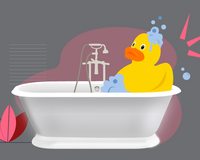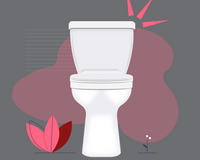Improving your home by adding an addition or renovating your current bathroom is a significant step to improving your daily life and the resale value of your property. However, it can be a difficult decision to pick either a shower or a bathtub. Each has pros and cons to consider, so we have listed them so you can choose the best option for your home.
Shower vs. Bathtub Installation
Tubs are often a more complex installation. The tub fixture itself is extremely heavy and requires two people to maneuver it into place. It is also an awkward shape and size, making it challenging to move around objects in your home without professionals.
Showers are by far easier to install than a tub. The pieces are broken down into smaller, more maneuverable sizes and require one person to move the supplies around. This allows for a less time-consuming installation and the need to move around furniture and fixtures.
If there are a lot of supplies or large moving pieces, fixtures such as the toilet and sink might need to be removed before the installation begins. These fixtures can get in the tub’s way and potentially become damaged. They could also interfere with the plumbing installation, so it might be simpler to remove them and reinstall them later.
There are many different shower and tub designs, so the extent of your fixture depends on the installation’s severity. Deciding to have a standard bathtub vs. a whirlpool tub or a standard shower stall vs. a walk-in shower will significantly affect your installation time and budget.
The plumbing and fortification are generally the same for each. The floor is fortified, and the piping is prepared before the actual pieces of the tub or shower are installed.
Shower vs. Bathtub Available Space
When picking a shower or tub, it is important to consider your size preference and/or the space available for an installation. If there is not enough room, the obvious choice would be a shower.
A standard tub ranges around 30 inches wide by 72 inches long. A shower stall is averaged 36 inches wide to 48 inches long. Bathrooms are not typically vast areas, so it is vital to consider the space that will be available. You could always knock out walls to accommodate a bathtub, but now you’ve given yourself less living area in a different room.
Shower vs. Bathtub Water Use
Showers typically use less water than a bathtub, depending on how long you take. The average bath uses around 35 gallons of water to fill to a comfortable level. A shower of approximately 10 minutes uses roughly 25 gallons of water. If you keep the shower relatively short, you will save on water consumption.
Shower vs. Bathtub Resale Value
It might seem like installing a shower is the obvious choice. However, bathtubs are considered to be more valuable in resale. People generally understand that bathtubs are more difficult and expensive to install, so they know they will have to pay more for the home to accommodate the luxury.
Freestanding bathtubs are also becoming more popular in the housing market. These tubs are viewed as more luxurious and bring the bathroom’s aesthetic together.
Even with the appeal of a bathtub, people generally use a shower more often. They are quicker to use and don’t take time to prepare. Because of this, it is plausible to install a shower tub combo. You can continue to have the luxury of a tub with the convenience of a shower.
Whether you pick a bathtub or a shower, it is highly recommended that you allow a professional plumber to do these installations. Water damage can become irreversible and cause significant damage to your home. If the plumbing and installation are not done correctly, it can cost you more money in the long run.
Your choice will depend on your preferences and available space, but you will be improving your home either way. Bathroom renovations are a fantastic way to refresh your home and quality of life, so don’t hesitate to give yourself that luxury.






